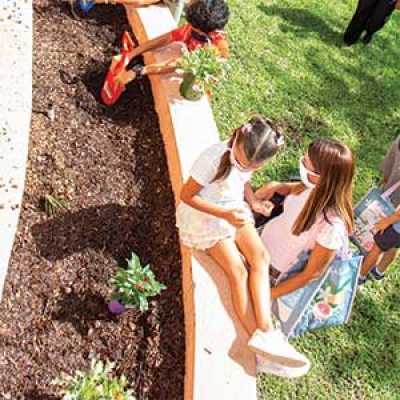Incorporating Roses For Cutting In The South Florida Garden
- January 11, 2021
- Victor Lazzari
The world of garden roses is a wonderfully diverse horticultural playground. In the most general sense, all roses are woody-stemmed perennial shrubs – but thanks to centuries of breeding, they now range in size from miniatures less than 12” tall, to massive climbers that can easily make their way up a 30’ tree. Add to this literally thousands of variations in flower color, shape, and fragrance, and you have a virtually limitless array of floral delights at your fingertips.

Abraham Darby: Copyright of Victor Lazzari
Roses, of course, are also beloved as the rock stars of the cut-flower world. Ever since ancient Roman times, cut roses have been used to ornament meals, parties, weddings, funerals – even war campaigns, believe it or not!

Flo Nelson: Copyright of Victor Lazzari
While the flower shops of today offer a variety of colorful long-stemmed roses, these pale in comparison to the beauty and fragrance of home-grown garden roses. Even the humblest of garden roses has a certain charm that her refrigerated sisters at the florist will never quite capture. Whatever message you want to convey – “I love you,” “I’m sorry,” “Welcome home,” “Get well soon,” or “Congratulations!” – that message becomes more sincere and meaningful when accompanied by flowers that you grew and nurtured all on your own.
Roses have a somewhat unfair reputation as being difficult to grow. Fortunately, a lot of this animus is mostly applicable to the hybrid teas – the aforementioned class of florist’s roses. Many of the roses in other classes – specifically the so-called “antique” or “old” roses, and the shrub roses – are easy-breezy, virtually trouble-free plants, with all the beauty of hybrid teas, breeders have pushed hard in recent decades to develop healthy, disease-resistant varieties more in sync with 21st-century gardeners and our eco-friendly, low maintenance attitude.
Excited? Great! Let’s get started!
Step 1: Site Selection
When it comes to growing roses in South Florida, the first step would be for the gardener to analyze their yard and make sure that existing conditions can accommodate these plants. The rose is a sun-lover by nature; a few varieties can tolerate light or partial shade, but none will succeed in dense, full shade. Too much shade greatly inhibits flowering and encourages fungal problems of all sorts.
Select a location in full sun, at least 8’ away from any small trees and 15-20’ from large trees. This will ensure that the roses aren’t shaded by nearby canopies, and will also prevent aggressive trees roots from sapping water and nutrients meant for them.

Poseidon: Copyright of Victor Lazzari
Step 2: Choosing Roses
Once a suitable area has been chosen, it’s time to decide what specific varieties you want to grow. Great local nurseries that stock Florida-friendly garden roses include: Galloway Farms (Miami), Living Color and NuTurf (Broward), and Cool Roses (West Palm Beach.) See the addendum at the end of this article for a list of good South Florida roses for cutting.
Choosing varieties may seem like an easy task, but in actuality may be the most frustrating and time-consuming part of the journey – garden roses here vary greatly in size. For example, if you love the deep crimson flowers of ‘Louis Philippe,’ prepare for a bulky shrub 8’ tall and 7’ across. By comparison, the soft lavender-gray blooms of ‘Poseidon’ come on a much narrower plant seldom wider than 4’ at maturity. I always bring my mobile device to nurseries, so that I can quickly Google a variety’s mature dimensions before purchasing it.
Be realistic with how many plants your space can fit – roses need good air circulation between individual plants and should never be crowded. The idea of having 20 different varieties in one bed may sound lovely, but if your space can only fit half that many plants, edit the list down to your top choices rather than trying to cram them all in.

Brian Michael: Copyright of Victor Lazzari
Step 3: Planting and Aftercare
For each rosebush, dig a hole approximately 16” across and 12” deep. Discard three-quarters of the excavated soil, and mix the remaining with a blend of equal parts topsoil, composted manure, and peat moss. Begin to backfill the hole a little, then place your potted rosebush inside the hole such that the soil line of the rose is level with the rest of the bed. Don’t be shy to add or take away soil from the hole until the two levels are equal – never bury your rosebush deeper than its current container level, nor leave it exposed above the bed’s existing grade.
Once leveled, begin filling the rest of the hole with your topsoil/manure blend, making sure to pack the soil down firmly so as to eliminate air pockets. After the soil has been backfilled and compacted, water the plant gently but thoroughly with a hose for a good 60 seconds. If you notice most of the water running away from the rose, create a small ring of soil around the outer perimeter of the plant to keep water in place. Continue watering daily, especially during very hot or dry weather, for four weeks. Afterward, as the plant becomes established, watering can be tapered down to once every few days or so.
Roses are voracious feeders and always do best with supplemental nutrition over the course of their garden tenure. Many garden centers stock pre-made “rose fertilizer” blends; or make your own using Epsom salt, bone meal, blood meal, and a slow-release all-purpose fertilizer like Osmocote. Apply at the manufacturer’s recommended doses. Coffee grounds from your kitchen are great as a topdressing!

Cut roses from my garden: Copyright of Victor Lazzari
Step 4: Cutting Your Roses
The best time to cut roses is either early morning or early evening. Cool, cloudy or overcast days are best, but if you must cut roses on a very hot or sunny day, try to do it as early as possible, ideally by 7 a.m.
Always use a sharp pair of secateurs (pruning shears with curved blades) to cut roses – this ensures clean cuts and will minimize any damage to the plant. Make your cuts at a 45-degree angle directly above a growth eye (where a leaf connects to the cane).
Try to choose stems that are at least 7” or longer in length; shorter stems may be difficult to arrange. While fully open blossoms are always appealing, buds that are half-open will result in longer-lasting arrangements; the buds will continue to open after being brought indoors.
Gathering fresh-cut roses in a basket may sound dreamy, but this is actually the most harmful method for doing so: They will quickly dehydrate and will have a short vase life as a result. The best means of gathering is to bring a bucket of lukewarm (never cold) water out into the garden with you. Cut your roses one at a time, immediately plunging them into water before cutting the next one.
When you are ready to arrange your flowers, be sure to give each stem a fresh cut with your secateurs and remove any foliage that will end up underwater in the finished arrangement.
And most importantly…have fun!
Addendum: Good Cut-flower Roses for South Florida
| Name | Class | Color |
|---|---|---|
| Abraham Darby | Shrub | Peachy pink |
| Belinda’s Dream | Shrub | Rich pink |
| Beverly | Hybrid tea | Deep pink |
| Cecile Brunner | Antique | Pale pink |
| Darcey Bussell | Shrub | Crimson purple |
| Etoile de Lyon | Antique | Buff yellow |
| Francis Meilland | Hybrid tea | White/pink blend |
| G. Nabonnand | Antique | Apricot/pink blend |
| Jude the Obscure | Shrub | Peach/apricot blend |
| Louis Philippe | Antique | Ruby red |
| Love | Hybrid tea | Red/white blend |
| Maggie | Antique | Cerise pink |
| Mrs. B R Cant | Antique | Red/pink blend |
| Poseidon | Floribunda | Lavender |
| Safrano | Antique | Buff yellow |
| St. Patrick | Hybrid tea | Citron yellow |
| Sugar Moon | Hybrid tea | Pure white |
| Tahitian Sunset | Hybrid tea | Orange/pink blend |
| Wollerton Old Hall | Shrub | Pale apricot/pink blend |
About the Author

Victor Lazzari is a landscape designer originally from the hilly farm country of Maryland. He holds a BA in Landscape Design from University of Maryland, an MA in Landscape Architecture from Florida International University, and a Masters Certificate in Agroecology, also from FIU. His small company, JungleGymFL, offers landscape design, consultation and project management services all over South Florida.
A Florida resident since 2007, Victor resides in Fort Lauderdale with his partner, Brian, and their two kids: Teddy, a young tuxedo kitten with dreams of world domination; and Tyson, a sycophantic black lab mix with an unhealthy fixation on tennis balls.
This series of articles from Victor Lazzari will inform you on how to grow roses and create beautiful cottage style gardens in the South Florida Landscape.
Sign up here for email notifications about new Hothouse Blog articles!
More articles on the subject:
More from our blogs
See all postsRecent Posts
- April 2023 April 1, 2024
- Good News on Environmental Plastics February 1, 2024
- Material World / Plant World January 1, 2024
Leave a Comment cancel
This site uses Akismet to reduce spam. Learn how your comment data is processed.
















Thank you so much for this article! I am growing a climber right now, “Souvenir de Mme Leonie viennot,” and anxiously waiting for some blooms. I also have some roses in containers in sunny spots on my patio that I bought from the Antique Rose Emporium out of Texas. I’m hoping to incorporate them into my landscape. Clearly, now is the time for that.
I love the Poseidon rose but can’t seem to find that anywhere. During your travels to nurseries, if you find them let me know…
Looking forward to your next articles!
A rose lover
Hi Rose Lover!
I’ve never grown Souvenir de Mme Leonie Vienna personally, so please keep notes about how she performs for you! And take lots of photos as well!
Antique Rose Emporium (ARE) is wonderful. They are a class act and have great product. I’ve probably ordered about $2000 worth of roses from them over the years. Yes, now (November through April) is the best time to plant new rosebushes.
For Poseidon, try K&M Roses in Mississippi, http://www.kandmroses.com. They’re a little slow to reply to emails, so try calling or texting.
One thing to remember about roses in South Florida is that, unless it’s an antique rose like your Souvenir, roses should be grafted on fortuniana rootstock, otherwise are subject to fatal damage from nematodes. The antique tea and China roses from ARE are fine, but for any modern hybrids like Poseidon, you want to make sure they’re fortuniana grafted.
Good luck and let me know how it goes!
Thanks for letting me know about the fortunia rootstock. I prefer the antique roses anyway, that is all I’m interested in, since I can get her refrigerated sisters anytime.
Thank you Victor for your wonderful article. I can almost smell your blooms. As one of the few members of the Coral Gables Garden Club who does not possess a green thumb, I will continue to “garden” by reading articles such as yours. Thanks again for sharing your vast knowledge. We appreciate your energy and enthusiasm.
Hi Suzuyo! Thanks for the great comment and very kind feedback. I’m glad the article was enjoyable and useful! Feel free to keep in touch!! 🙂
Hi Victor,
I loved your article and was just dreaming of growing 2 or 3 especially fragrant antique roses. Can you recommend some small ones? My garden is so full, That’s probably all I can fit! Also wondering which app you consult for advice on rose qualities and dimensions. Thanks again for this wonderfully informative article.
Warmly, Judy
Just saw the other half of your question!
The best website for rose qualities/dimensions is http://www.HelpMeFind.com. Simply click on the ROSES category, and then type in the name of the variety you want to look up in the SEARCH box. This is a wonderful resource for anyone curious about roses!
hi Judy!
Thanks for the great comments! Yes, absolutely – there are many antique roses that are not humongous giants. Here’s a list of varieties that will reliably stay under 4′ tall without any drastic pruning:
– Francis Dubreuil, very dark scarlet with a powerful damask fragrance
– Ducher, pure white, strong tea & honey fragrance
– Spice (aka Bermuda Spice, aka Hume’s Blush) blush pink, spicy peppery scent
– Rose de Rescht, rich crimson purple, intense fruity damask fragrance
– Souvenir de St. Anne’s, light pink, powerful spicy rose fragrance
– Sai Zhau Jun, pink/apricot blend, strong sweet fragrance
All of these are available from either http://www.RosePetalsNursery.com or http://www.AntiqueRoseEmporium.com. Good luck!!
Thank you so much for the information, Victor. I’ll take a screen shot for posterity!
Victor’s writing about roses is only surpassed by his in-person talks. What a talent! I loved this informative article on roses and enjoyed the beautiful photos that accompanied it. I especially liked the chart of roses suitable for growing in S. Florida. Thank you, Victor!
Thanks Kitty, for the very kind words! 🙂
Victor…thank you for your very informative articles you are sharing with us. I’m a rose gardener from waaaay back (up north) and always cautious about starting here. Your list of rose varieties that are suitable for our climate will be invaluable. Can’t wait to get started. Any comments on Sharifa Asma?
hi Sharon!
Thanks for the great feedback – my book, “100 Roses for the South Florida Garden” should be available later this year and will indeed have literally 100 rose varieties that all do well south of Lake Okeechobee!
Sharifa Asma (the name is pronounced “SHARE-if’uh OZ-muh, not “Sha-REEFA Asthma”) is a gorgeous rose that does well here, but she’s a bit of a diva. She was named after an Omani princess, which is fitting because this rose needs a lot of pampering. Make sure she is planted in the best location possible (open and sunny but away from reflected heat surfaces), the best soil possible (basically pure composted manure mixed with peat moss), regular irrigation and regular feedings, and an organic mulch all year long. The rewards are worth the effort: large pale blush pink flowers with an indescribably rich, almost intoxicating fragrance. Even with the best of care, she will be a small, slow growing plant, maybe 3′ tall at the most. For this reason she works well in a container where she can get all the TLC that she needs. If you grow her in a pot, make sure you use the best potting mix you can find!
If you’re looking for a larger plant, there is a climbing rose called ‘Nahema’ that is distantly descended from Sharifa Asma and has almost identically similar flowers with the same incredible fragrance, but on a vigorous climbing rose. If you have the space, I would actually recommend Nahema over Sharifa Asma simply because she grows faster and bigger and will provide you with that many more flowers.
Thanks for the great question and keep them coming!